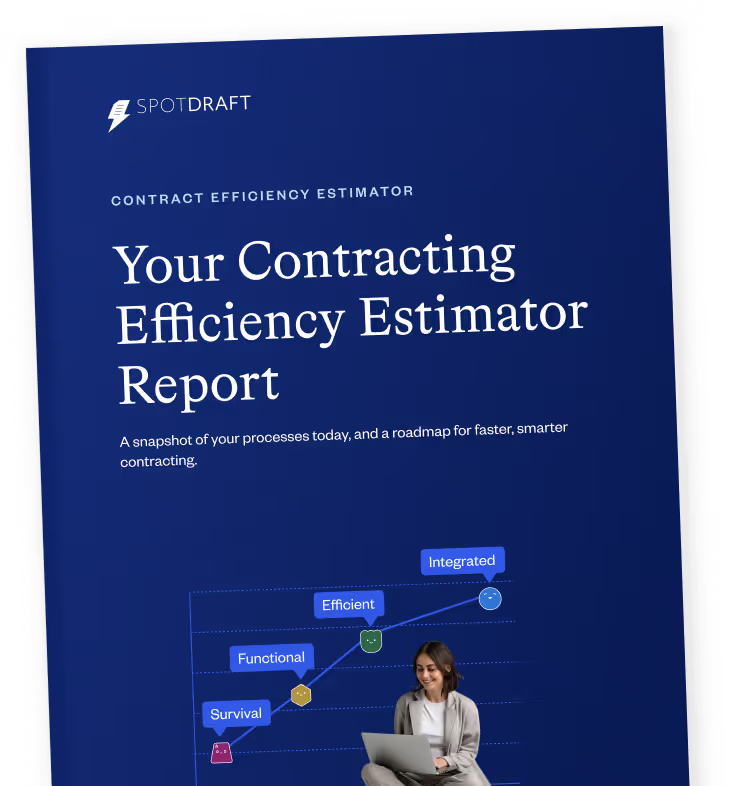No matter how carefully you draft your organization's business contracts, accounting for every possible scenario is impossible. But with a limitation of liability clause, you can minimize the risks, limiting your company's exposure to financial losses in case business goes sour.
However, a limitation of liability clause is not a blanket protection. Implement it the wrong way, and you'll be firing blanks in court!
In this guide, we have explained everything you should know about this provision, including key elements and factors that impact its enforceability.
Also read: 5 Most Negotiated Terms and Clauses in a Contract
What is a limitation of liability clause?

Source: Gemma Nugent via LinkedIn
A limitation of liability clause is a provision that "limits" how much one party must pay the other for damages arising from a breach of contract, performance failure, or other specified circumstances.
It allows parties to agree ahead of time on the maximum amount of financial exposure they are willing to accept if problems arise during the span of the contract.
Imagine you run a software business that develops sophisticated inventory management systems, and you're about to sign a contract with a large retail chain. Before signing the contract, you and the retailer agree to incorporate the "limitation of liability" clause.
The liability clause limits the amount of money your business would have to pay the retailer if the software malfunctions or causes problems. For instance, if the software glitches and causes the retailer to lose sales or mismanage inventory, the clause might state that your company will only compensate them up to a certain amount, even if the actual financial losses are higher.
But if your company provides faulty code or misrepresents the software's capabilities due to recklessness, you might be mandated to compensate the retailer in full for any damages that occur as a result. This is called an exclusion (more on this later).
Also read: 6 essential types of contract clauses you need to know
Standard terms present in a limitation of liability clause

Source: Jonathan Steele via X
A limitation of liability clause has a fairly straightforward structure. The specific language can vary based on the nature of the contract, the negotiation skills of the contracting parties, and the regulatory policies controlling business in that jurisdiction. However, their building blocks remain mostly the same.
Here are some of the key elements contained in a typical limitation of liability clause:
#1 Scope of limitation
This is where you find all the types of claims or damages subject to the limitation of liability clause. This section typically covers all direct, indirect, incidental, punitive, or consequential damages resulting from using a contracting partner's products or professional services.
#2 Liability cap
This sets a limit on the amount of damages one party can recover from the other. The exact amount depends on your arrangement with your counterparty. You can choose a fixed amount, but a multiple of the contract value is also commonplace.

Source: Chris Deubert via LinkedIn
#3 Exclusions
This is where you outline damages that the liability limitation clause won't cover. Such damages may include those resulting from fraud, willful misconduct, or violation of law by either party
#4 Time limit
Some clauses may specify a time limit within which a claim must be brought. This can help to prevent stale claims and ensure that disputes are resolved promptly.
#5 Survival of the clause
This provision clarifies whether the limitation of liability will continue or cease to apply after the termination of the contract. It is important to consider whether certain liabilities may arise after the contract has ended, such as those related to confidentiality or intellectual property.
#6 Severability
“Without a severance clause (sometimes called a “savings” clause), a voided clause may cause the entire agreement to fail.
~Sterling Miller, CEO and Senior Counsel for Hilgers Graben PLLC
Ten Things: I Know It’s Only Boilerplate (But I Like It)!
This provision states that if any part of the limitation of liability clause is found unenforceable, the remaining parts of the clause will still be enforceable to the full extent permitted by law. This ensures the clause's overall intent remains intact even if a specific provision is nullified.
#7 Governing law
This provision specifies the jurisdiction whose laws will govern the interpretation and enforcement of the limitation of liability clause. This helps avoid conflicts of laws and ensures that the clause is interpreted consistently with the legal framework intended by the parties.
Importance of having a limitation of liability provision in your contract

Source: The Law Shorts via X
A limitation of liability clause is not a mere "nice-to-have." It is a "must-have" component of a well-rounded contract, as excluding it can expose your organization to unimaginable risks.
But if used correctly, it can benefit your organization in many ways, including:
#1 Financial protection
”You can either be part of the cleanup crew or do stuff to avoid that cleanup situation altogether."
~Gitanjali Pinto Faleiro, General Counsel, Company Secretary & CCO at Greenhill & Co.
Navigating the C-Suite as a GC
Your limitation of liability clause protects your business from unmanageable financial losses.
As already explained, it does this by limiting your financial risk exposure to a specific amount negotiated with the counterparty. This is especially important in high-risk industries or for a business entity with limited resources.
With this provision, you can avoid being forced to pay for damages that exceed your expectations or ability to pay.
#2 Encouraging contract formation
Being able to negotiate and cap your risk exposure to a fair amount encourages a more positive business atmosphere. Partners are more willing to enter into agreements they'd typically consider too risky.
This can result in increased business opportunities and mutually beneficial arrangements.
#3 Dispute resolution
“While it is always very exciting to enter into a new agreement with another party, I always remember that you need to plan for the divorce. The time to do that is at the beginning of the relationship.”
~Sterling Miller, CEO and Senior Counsel for Hilgers Graben PLLC
Ten Things: I Know It’s Only Boilerplate (But I Like It)!
If business goes sour and you end up in a dispute with your partner, a limitation of liability clause can help with faster resolution. Since both parties already have an established cap on damages, there'll be fewer back-and-forths on the extent of liability, saving you time and money in legal fees.
Also read: Finding Common Ground: How to Resolve Contract Disputes
#4 Balancing risk and reward
“To me, a risk only matters if it's material. If it’s immaterial, I don’t care about it. If it's likely to occur but it's not very costly, I probably don't care. If it's unlikely to occur but, man, if that meteor hit the earth today, it would be bad — I also don't care. It's just not likely to happen.”
~ Jonathan Franz, Head of Legal at Crunchbase.
Navigating Economic Turbulence and Thriving in Chaos
A limitation of liability clause can help businesses strike a balance between the risks and gains associated with their agreements. One party may aim for a lower cap on damages but will balance this by agreeing to more favorable terms elsewhere.
For example, as a software development company, you might negotiate a lower limit for damages in exchange for a longer warranty period or a more flexible payment plan.
This can ultimately bring about a more equitable and mutually beneficial agreement.
Also read: Legal Risk Management: From the Playbook of 11 GCs & Leaders
Factors that impact the enforceability of a limitation of liability clause
"If someone said you can only work on one section of a contract, I would always pick the section dealing with indemnification, limitation of liability, and warranty. Or, as I call them, the "Big Three." While usually falling in the boilerplate section of the agreement, there is little that is standard about these three clauses. They are also typically the most heavily negotiated clauses in the entire agreement. Why? Because they shift and cap/uncap exposure when things go wrong under the contract."
~Sterling Miller, CEO and Senior Counsel for Hilgers Graben PLLC
Ten Things: I Know It’s Only Boilerplate (But I Like It)!
While a limitation of liability clause is valuable, its enforceability during a lawsuit is not guaranteed. Courts and legal systems have established several criteria to determine whether contracting parties can enforce specific clauses.
If you want to draft limitation of liability clauses that hit the mark during legal proceedings, you must take note of the following:

Source: Steven Haddock via Quora
#1 Unambiguous language
The language and specific wording contained in the limitation of liability clause contribute significantly to its enforceability. If you use overly complex terms or fail to be specific about the damages your clause covers, its limits, and exclusions, you'll have problems with misinterpretation by the other party, making enforcement difficult.

Source: Faros Legal via LinkedIn
#2 Equality of bargaining power
An enforceable limitation of liability provision must show that both parties have a fairly distributed bargaining power. If one party has substantially more leverage, courts might view the clause as unconscionable or unfairly imposed.
Also read: Mastering the Art of Contract Negotiation—Strategies for Success
#3 Governing law and jurisdiction
The binding nature of a limitation of liability clause can also be influenced by the governing law and jurisdiction specified in the contract. Different legal systems have varying approaches to these clauses, and parties should be aware of any relevant statutory or case law restrictions.
#4 Proportionality
When setting your liability limit, weigh it against the risks and strike a solid balance. If the cap is set too low compared to the potential damages, courts might consider it unfair to the other party and unenforceable.
#5 Public policy considerations
You have a better chance of enforcing your limitation of liability provision if it complies with established public policies.
If the clause attempts to limit liability for actions that are considered harmful or reprehensible, the court may refuse to support it.
For example, putting a limit on liability for injuries caused by a faulty product will present your business as one that disregards product safety regulations and discourage manufacturers from taking necessary precautions. Such a clause will have no impact in court.
Draft better limitation of liability clauses with VerifAI
Do you have a history of struggling with enforceability, or are you simply trying to get your limitation of liability clauses right from the get-go? In both cases, an efficient contract review process can make a world of difference for your organization.
Powered by the collective expertise of over 100 top legal professionals, VerifAI allows you to review your entire contract against established guidelines, highlighting areas of non-compliance and risks in seconds.
For every highlight it generates, the tool gives a detailed explanation alongside references for better clarity. It also suggests redlines, so you can quickly make corrections.
Thanks to its Natural Language Processing (NLP) capabilities, VerifAI can also answer direct, open-ended questions about any part of your contract. The result? You achieve limitation of liability clauses that are more precise, comprehensive, and legally sound.
Click here to get a free trial.

.png)







